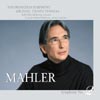Mahler Symphony No 2
A spectacular recording helps MTT and Co storm the heavens in Mahler
View record and artist detailsRecord and Artist Details
Composer or Director: Gustav Mahler
Genre:
Orchestral
Label: Avie
Magazine Review Date: 3/2005
Media Format: Super Audio CD
Media Runtime: 89
Mastering:
Stereo
DDD
Catalogue Number: 821936 0005/6-2

Tracks:
| Composition | Artist Credit |
|---|---|
| Symphony No. 2, 'Resurrection' |
Gustav Mahler, Composer
Gustav Mahler, Composer Isabel Bayrakdarian, Soprano Lorraine Hunt Lieberson, Mezzo soprano Michael Tilson Thomas, Conductor San Francisco Symphony Chorus San Francisco Symphony Orchestra |
Author: Andrew Farach-Colton
Michael Tilson Thomas and the San Francisco Symphony’s Mahler cycle regains its stride with this imaginative and compelling recording of the Resurrection Symphony. The orchestra’s playing is stunning, as it has been throughout the series. Rarely have the lyrical sections of the opening movement sounded so tender, songful and radiant. And these soft oases stand in stark contrast to the sharply etched character of the rest of the movement, which is expansively paced yet extremely taut; even the silences crackle with electricity and anticipation.
The second movement, also on the slow side, is uncommonly delicate. In one of his early programmes for this work, Mahler described this Andante moderato as ‘a memory – a shaft of sunlight from the life of [the symphony’s] hero’. And, indeed, the impression one gets here is of a precious, fleeting remembrance. On the other hand, the Scherzo is nimbler and considerably less fierce than usual, with the music’s grotesqueries played down. The intricacy of the scoring is realised with elegant precision, however, and the result is a playful, cheeky corollary to the fragile nostalgia of the Andante.
‘Urlicht’, which can often seem a mere prelude to the finale, here becomes a peak of quiet yet astonishing power, thanks largely to Lorraine Hunt Lieberson’s emotionally focused singing. So hushed is her tone in the opening phrases, one feels she’s whispering in your ear, and the final pages are positively beatific – a soul-soothing experience that makes the explosion that follows all the more disorienting.
There are a few disappointments in the finale: Mahler’s depiction of the opening of graves and march of the dead needs to be wilder, more terrifying, and one wants a soprano with less fluttery tone than Isabel Bayrakdarian, as well as greater presence from the choir. But Tilson Thomas shapes this vast movement intelligently, creating a feeling of spiritual growth and development that leads naturally to a foundation-shaking, resplendent conclusion. Top honours remain with Bernstein, Rattle and Walter, but this spectacularly recorded newcomer offers sufficient insight and sense of occasion to merit a strong, positive recommendation.
The second movement, also on the slow side, is uncommonly delicate. In one of his early programmes for this work, Mahler described this Andante moderato as ‘a memory – a shaft of sunlight from the life of [the symphony’s] hero’. And, indeed, the impression one gets here is of a precious, fleeting remembrance. On the other hand, the Scherzo is nimbler and considerably less fierce than usual, with the music’s grotesqueries played down. The intricacy of the scoring is realised with elegant precision, however, and the result is a playful, cheeky corollary to the fragile nostalgia of the Andante.
‘Urlicht’, which can often seem a mere prelude to the finale, here becomes a peak of quiet yet astonishing power, thanks largely to Lorraine Hunt Lieberson’s emotionally focused singing. So hushed is her tone in the opening phrases, one feels she’s whispering in your ear, and the final pages are positively beatific – a soul-soothing experience that makes the explosion that follows all the more disorienting.
There are a few disappointments in the finale: Mahler’s depiction of the opening of graves and march of the dead needs to be wilder, more terrifying, and one wants a soprano with less fluttery tone than Isabel Bayrakdarian, as well as greater presence from the choir. But Tilson Thomas shapes this vast movement intelligently, creating a feeling of spiritual growth and development that leads naturally to a foundation-shaking, resplendent conclusion. Top honours remain with Bernstein, Rattle and Walter, but this spectacularly recorded newcomer offers sufficient insight and sense of occasion to merit a strong, positive recommendation.
Discover the world's largest classical music catalogue with Presto Music.

Gramophone Digital Club
- Digital Edition
- Digital Archive
- Reviews Database
- Full website access
From £8.75 / month
Subscribe
Gramophone Full Club
- Print Edition
- Digital Edition
- Digital Archive
- Reviews Database
- Full website access
From £11.00 / month
Subscribe
If you are a library, university or other organisation that would be interested in an institutional subscription to Gramophone please click here for further information.




